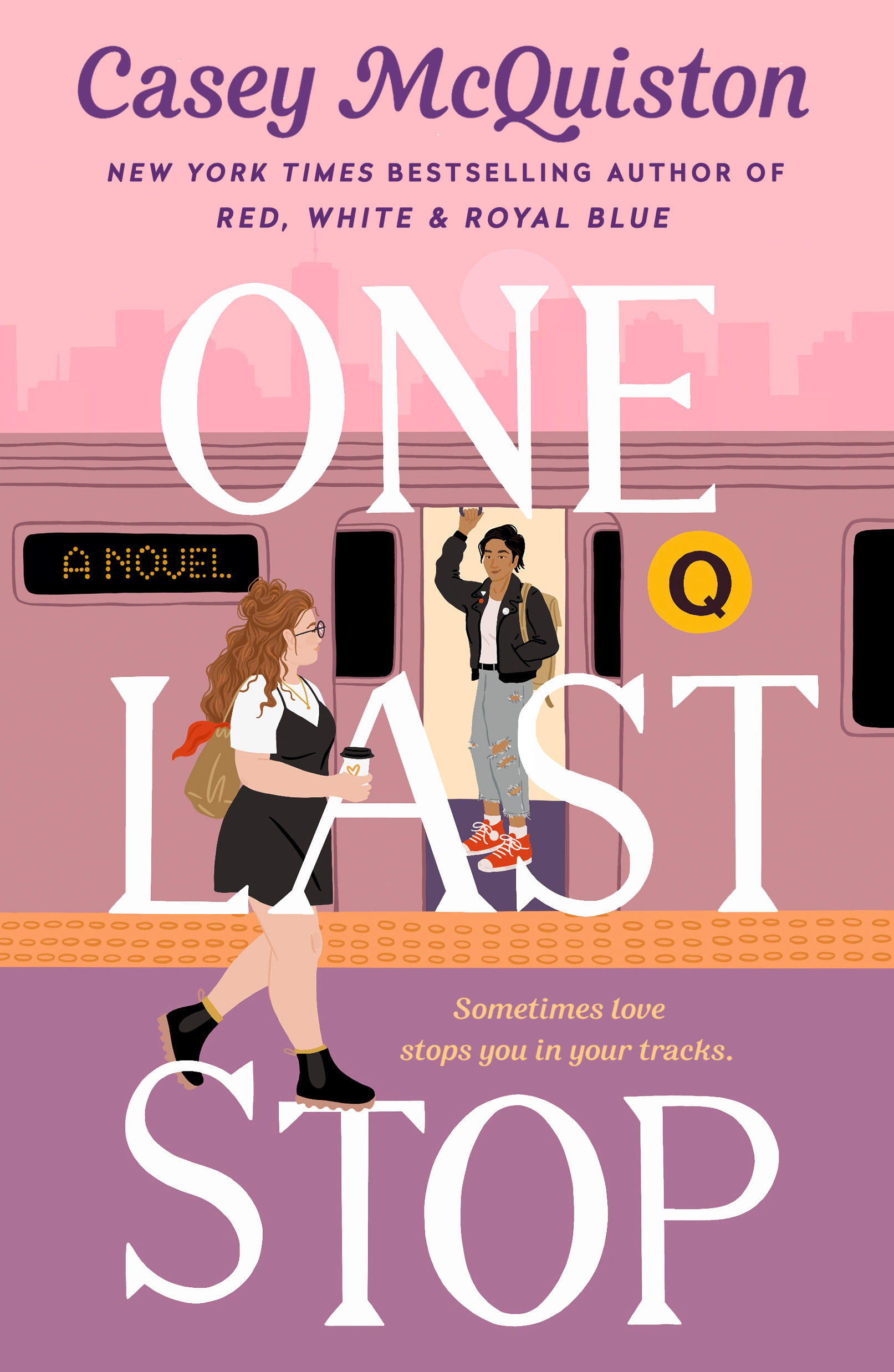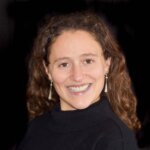Casey McQuiston cemented themself as a queer icon with the commercial and critical success of their 2019 debut rom com novel, Red, White & Royal Blue, a love story between the First Son of the United States and the Prince of England. McQuiston captivated readers with complex and loveable queer characters while showcasing their ability to examine politics and sexuality in a light, fun and engaging way—perfect reading for our fraught political climate.
Now, McQuiston has graced us with another, even queerer romance, this time between two women.
Their latest novel, One Last Stop, is a queer time travel adventure. Excited to show their range as a writer, McQuiston moves on from the coming-out story of Red, White & Royal Blue to give their queer characters potent lives beyond it.
Twenty-three-year-old August, lonely and insecure, has just moved to New York City when she meets the alluring, leather jacket-clad Jane on the subway. For some reason, the two of them cannot stop running into each other on August’s daily commute.
Although they often chat, August doesn’t know much about Jane. But she does know one thing: She’s falling hopelessly and desperately in love with her. Soon, August discovers Jane is actually displaced in time from the 1970s, trapped in the present day with absolutely no idea how she got stuck. What’s more, Jane cannot leave the subway.
August embarks on an ambitious quest to send Jane home—but she doesn’t do it alone. When she moves to New York City, August begins living with a vibrant cast of queer roommates: Niko, a psychic; Myla, a sculptor; and Wes, a moody tattoo artist. Then there’s Isaiah, who lives across the hall, is madly in love with Wes and is also a drag queen who goes by Annie Depressant. In this loving, dynamic group, August finds a family, one who drops everything to help her save Jane.
But as the pair fall deeper in love, they begin to worry about what will happen if August actually succeeds.

Credit: St. Martin's Publishing Group
As with Red, White & Royal Blue, McQuiston’s storytelling is enchanting. Warm, inviting and with the perfect dose of magical realism, One Last Stop will easily envelop readers into its delightful queer universe—one they will surely never want to leave.
McQuiston, born and raised in Southern Louisiana, was living in Colorado at the time they began work on One Last Stop. While doing the research, they became so enamoured of the book’s New York City setting, they decided to move there in the midst of writing it.
How did you get the idea for One Last Stop?
I always wanted to do a time travel romance, sort of that impossible, against-all-laws-of-the-universe type of romance. I’ve always been a sucker for that type of story in fiction, so I was really excited to do my own version.
I was on my first trip to New York when I really got to know the subway well. It feels a bit like a liminal space; I thought it was a cool opportunity to do some kind of time-bendy love story that revolves around that classic trope of strangers on a train meeting and plays with it.
As soon as I figured out it was going to be a time-travel romance, that was when [I created] all the other layers of what Jane would be and what type of time traveller she would be.
Was Jane the first character you created?
Yeah, Jane is the entire centre of the book. August is our protagonist and our POV character, but everything was built around Jane.
The loveable supporting characters give this book so much life. How did you build the beautiful queer world that August falls into?
A lot of the story is about different kinds of family. August doesn’t have much family, and a lot of her life has been about this family baggage her mom carries. She has this concept of family as something that’s not really for her. I wanted to show somebody like her finding her own family; in my experience as a queer person, you find that in other queer people.
Ultimately, the world I was trying to create was one that looks like the world I live in: my friends, the weird neighbours and co-workers I’ve had.
“We can get stuck on the coming-out story and forget it’s just the beginning. There’s so much about queer life after coming out.”
I was trying to capture this very specific part of your 20s where you’re lost and don’t know who you are or what you’re doing. The people that get you through that are often these random people who stumble into your life and turn out to be your strongest support system—even more so for queer people.
I wanted August to have that. I wanted to show a character like her finding that.
In Red, White & Royal Blue, sexuality is a big deal. In One Last Stop, queerness is the norm. Was that shift intentional?
Red, White & Royal Blue reflects more of where I was in my coming-out journey when I was writing it five years ago. That was a period of my life where I was trying to figure out how my queerness fit in with my environment. I think One Last Stop reflects me being a few years farther down the road.
I think coming-out stories are really important and valuable, but I also think that often we can get stuck on the coming-out story and forget it’s just the beginning. There’s so much about queer life after coming out.
I wanted to write a story about queer people living their lives and just existing and falling in love and having a crazy, fantastical time-travel adventure.
Was there a big difference for you in writing a romance between two men versus two women?
It would be different no matter what I was writing. The cool thing about the queer experience is it’s very multifaceted; there’s no singular queer experience. I could write my next 300 books about women falling in love with other women and they would still all be different.
Do you enjoy playing with conventional romance novel tropes in your writing?
I think certain formulas that are used repeatedly in a genre are there because they work.
For example, a big thing in romance is that, around 75 percent into the book, there’s usually some type of fight or breakup. I use that every time. I enjoy it, I have fun with it. There are a lot of things in rom coms that just make my heart happy, and I want to play with them and put my own spin on them.
“A waitress protagonist is a fun stock character you’ve seen before, but there are a million ways to do that.”
I honestly love a tropey romance novel. There’s something really comforting about it. If a story has beats that feel familiar but new, I find that really exciting and fun. I feel safe in it, but also excited to see how that author is going to do it. I try to do the same thing in my books where I take something that feels really familiar to you [and mix it up].
Like, a waitress protagonist is a fun stock character you’ve seen before, but there are a million ways to do that. With August, she’s a waitress, but she’s really bad at it, and she works at a 24-hour pancake diner.
Because of the popularity of Red, White & Royal Blue, was it a different experience writing this book knowing you have a huge audience waiting for it?
My biggest strength as a writer is being able to commit 1,000 percent to whatever my crazy idea is and really sell it.
At first, it was really hard to do that [with One Last Stop] once I knew somebody was going to read it. It wasn’t until my second draft that I told myself, “Let’s pretend no one but me will ever read this, and write what you want to read.” I wrote such a better draft after that.
“I want people to do thirst posts about Jane because I think she’s amazing.”
This book is super different from Red, White & Royal Blue on purpose. I wanted to show I have range and that I can do more than what people know me for. So that’s a little scary because when people really love something, sometimes they just want more of that thing, and that’s not what this is.
But I really love it, and I love that I can love both of these things and they can both be my work. I hope people will feel the same way.
Did the pandemic affect your writing at all?
Not much of this book was written during COVID-19. My third book was my little COVID-19 baby. But I write rom com, and it was really hard to put myself in the mindset of a happy little love story at the height of COVID-19 in New York.
Can you share anything about your third book?
It’s another queer ensemble rom com, my first young adult one. It’s set in the Bible Belt of central Alabama at a conservative religious high school. It’s about the prom queen who runs away on prom night and the three kids she kissed before she left. The three of them try to figure out where she went and why. It’s really fun.
Are you excited to see One Last Stop in the hands of readers?
I wrote my first draft in 2018, so to have it out in the world and have other people care about it the way I care about it will be so exciting.
I think Jane is primo book girlfriend material, and I just want her to have her day. I want people to do thirst posts about Jane because I think she’s amazing. I love her a lot, and I really hope people love her, too.
This interview has been edited for length and clarity.


 Why you can trust Xtra
Why you can trust Xtra


